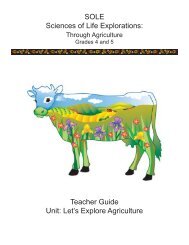Insect Anatomy - Agriculture in the Classroom
Insect Anatomy - Agriculture in the Classroom
Insect Anatomy - Agriculture in the Classroom
You also want an ePaper? Increase the reach of your titles
YUMPU automatically turns print PDFs into web optimized ePapers that Google loves.
SUMMARY OF CONTENT<br />
TEACHING- LEARNING ACTIVITIES<br />
I.<br />
Don’t bug me!<br />
A. Gets students th<strong>in</strong>k<strong>in</strong>g about bugs and<br />
<strong>in</strong>sects, and emphasizes that <strong>the</strong>y are<br />
all around us.<br />
I.<br />
Don’t bug me!<br />
A. Discuss this page as a class to start<br />
discussion on bugs and <strong>in</strong>sects and<br />
stimulate <strong>in</strong>terest.<br />
II.<br />
III.<br />
What do you know about <strong>in</strong>sects<br />
A. Questions and basic facts about <strong>in</strong>sects.<br />
What is an <strong>in</strong>sect<br />
A. Students are asked pick <strong>in</strong>sects out of a<br />
group of similar creatures<br />
B. Terms <strong>in</strong>clude entomologist and<br />
amateur<br />
II.<br />
III.<br />
What do you know about <strong>in</strong>sects<br />
A. Use <strong>the</strong> questions provided as discussion<br />
po<strong>in</strong>ts <strong>in</strong> class.<br />
What is an <strong>in</strong>sect<br />
A. Read <strong>the</strong> first paragraph toge<strong>the</strong>r.<br />
B. Students may complete <strong>the</strong> page<br />
<strong>in</strong>dividually.<br />
IV. Test your knowledge<br />
A. Questions related to <strong>in</strong>sect identification.<br />
IV. Test your knowledge<br />
A. Students may complete this page<br />
<strong>in</strong>dividually.<br />
A. Discuss responses as a class.<br />
V.<br />
How many legs does an <strong>in</strong>sect have<br />
A. Complete a chart <strong>in</strong> order to identify<br />
<strong>in</strong>sects.<br />
V.<br />
How many legs does an <strong>in</strong>sect have<br />
A. This could be completed <strong>in</strong>dividually or<br />
as a class<br />
VI. What does anatomy mean<br />
A. Label <strong>the</strong> parts of a ladybug.<br />
B. The read<strong>in</strong>g expla<strong>in</strong>s antennae,<br />
abdomen, exoskeleton, and molt.<br />
VII. More <strong>in</strong>sect parts!<br />
A. Label <strong>the</strong> parts of a butterfly.<br />
VIII. W<strong>in</strong>gs<br />
A. Compares <strong>the</strong> types of w<strong>in</strong>gs used for<br />
flight.<br />
B. Terms <strong>in</strong>clude mammals, passive,<br />
membrane, and muscles.<br />
IX. Mouthparts<br />
A. Illustrations and discussion about types<br />
of mouthparts<br />
i. Chew<strong>in</strong>g<br />
ii. Suck<strong>in</strong>g<br />
i. Pierc<strong>in</strong>g and suck<strong>in</strong>g<br />
VI. What does anatomy mean<br />
A. This could be completed <strong>in</strong>dividually or<br />
as a class.<br />
VII. More <strong>in</strong>sect parts!<br />
A. This could be completed <strong>in</strong>dividually or<br />
as a class.<br />
VIII. W<strong>in</strong>gs<br />
A. Students could take turns read<strong>in</strong>g aloud.<br />
A. Students could compare <strong>the</strong> human<br />
thorax to <strong>the</strong> <strong>in</strong>sect thorax.<br />
IX. Mouthparts<br />
A. Students could label <strong>the</strong> pierc<strong>in</strong>g and<br />
suck<strong>in</strong>g mouthparts illustration and<br />
compare it to <strong>the</strong> o<strong>the</strong>r two types of<br />
mouths.<br />
B. Discuss how o<strong>the</strong>r animals’ mouths are<br />
designed to eat specific foods<br />
i. Wlid cats - sharp teeth for raw meat<br />
ii. Baleen whale - dental comb to stra<strong>in</strong><br />
plankton
















